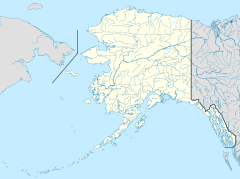Operation Breakthrough facts for kids
Quick facts for kids
Point Barrow
Nuvuk
|
|
|---|---|
|
Northernmost point of the US
|
|
| Country | |
| State | |
| Borough | North Slope |
| Time zone | UTC-9 (Alaska (AKST)) |
| • Summer (DST) | UTC-8 (AKDT) |
Operation Breakthrough was a special rescue mission in 1988. It was a joint effort between the United States and the Soviet Union. Their goal was to free three gray whales that were stuck in thick ice near Point Barrow in Alaska.
The whales' difficult situation caught the attention of many people. News stories led to different governments and groups working together to help. Sadly, the youngest whale died during the rescue. It's still not known if the other two whales survived in the end.
Contents
The Whale Rescue Mission
Whales Trapped in Ice
On October 7, 1988, an Inupiaq hunter named Roy Ahmaogak found three gray whales. They were trapped in a large area of ice in the Beaufort Sea. This was near Point Barrow, in the state of Alaska.
The hunter immediately tried to help. He used a chainsaw to cut a path through the ice. He hoped this path would lead the whales to open water. Other villagers joined in to help. They used water pumps to stop the ice from freezing again overnight.
News Spreads and Help Arrives
Word about the trapped whales quickly spread through the Inupiat community. Biologists from the North Slope Borough visited the site. They quickly understood how much danger the whales were in. A large helicopter, a Sikorsky S-64 Skycrane, was brought in. It used a heavy 5-ton hammer to break more holes in the ice.
A week later, the first news story about the whales appeared in Anchorage. Rescuers tried to get a large boat called a barge from Prudhoe Bay. They wanted to use it to break the ice. However, the barge was stuck and could not be moved.
International Cooperation
More and more news reporters started calling the North Slope Borough. They also flew to the site to cover the story. The whales' struggle gained a lot of media attention. The National Oceanic and Atmospheric Administration (NOAA) sent a team of whale experts.
The United States Department of State asked the Soviet Union for help. The Soviets quickly sent two powerful icebreaker ships. These ships were named the Vladimir Arseniev and the Admiral Makarov.
Challenges and Sadness
When the whales tried to use the new path, many journalists were too close. This caused the whales to swim back to their original spot. The sharp edges of the broken ice also cut the whales. This made the water around them bloody.
The whales stayed in their first area for a while. They were given Inuit names: Putu, Siku, and Kanik. They also received English names: Bonnet, Crossbeak, and Bone. Sadly, the youngest whale, Bone, who was nine months old, died on October 21.
The Final Push
On October 28, the Soviet icebreaker Admiral Makarov made a huge breakthrough. It broke apart a massive ridge of Arctic ice. This ice ridge was 400 yards wide and 30 feet high. The other Soviet ship, the Vladimir Arseniev, then cleared away the broken ice. This created a large path. The path was big enough for the two remaining whales to swim to open water.
After the path was cleared, observers could no longer see the whales. The operation was then announced as a success. However, the two remaining whales were reportedly very sick at the time. They were never tagged with radio trackers. Because of this, no one knows if they truly survived.
Looking Back
The entire rescue effort cost about US$1 million. Some scientists criticized the high cost. However, a whale expert said the rescue changed how people view whales. They said it showed a new way humans felt about these amazing creatures.


